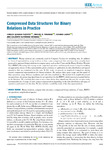Compressed Data Structures for Binary Relations in Practice

Use este enlace para citar
http://hdl.handle.net/2183/25445Coleccións
- GI-LBD - Artigos [33]
- OpenAIRE [266]
Metadatos
Mostrar o rexistro completo do ítemTítulo
Compressed Data Structures for Binary Relations in PracticeData
2020-01-31Cita bibliográfica
C. Quijada Fuentes, M. R. Penabad, S. Ladra and G. Gutiérrez Retamal, "Compressed Data Structures for Binary Relations in Practice," in IEEE Access, vol. 8, pp. 25949-25963, 2020.
Resumo
[Abstract] Binary relations are commonly used in Computer Science for modeling data. In addition to classical representations using matrices or lists, some compressed data structures have recently been proposed to represent binary relations in compact space, such as the k 2 -tree and the Binary Relation Wavelet Tree (BRWT). Knowing their storage needs, supported operations and time performance is key for enabling an appropriate choice of data representation given a domain or application, its data distribution and typical operations that are computed over the data. In this work, we present an empirical comparison among several compressed representations for binary relations. We analyze their space usage and the speed of their operations using different (synthetic and real) data distributions. We include both neighborhood and set operations, also proposing algorithms for set operations for the BRWT, which were not presented before in the literature. We conclude that there is not a clear choice that outperforms the rest, but we give some recommendations of usage of each compact representation depending on the data distribution and types of operations performed over the data. We also include a scalability study of the data representations.
Palabras chave
Computational complexity
Data compression
Data structures
Matrix algebra
Trees (mathematics)
Data compression
Data structures
Matrix algebra
Trees (mathematics)
Versión do editor
Dereitos
Atribución 4.0 España http://creativecommons.org/licenses/by/4.0/
ISSN
2169-3536





